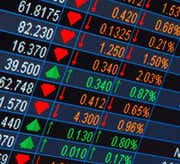The stochastic oscillator is another well-known momentum indicator used in technical analysis. The idea behind this indicator is that the closing prices should predominantly close in the same direction as the prevailing trend.
In an upward trend the price should be closing near the highs of the trading range and in a downward trend the price should be closing near the lows of the trading range. When this occurs it signals continued momentum and strength in the direction of the prevailing trend.
The stochastic oscillator is plotted within a range of zero and 100 and signals overbought conditions above 80 and oversold conditions below 20. The stochastic oscillator contains two lines. The first line is the %K which is essentially the raw measure used to formulate the idea of momentum behind the oscillator. The second line is the %D which is simply a moving average of the %K. The %D line is considered to be the more important of the two lines as it seen to produce better signals.
The stochastic oscillator generally uses the past 14 trading periods in the calculation but can be adjusted to meet the needs of the user.
Calculation of the Stochastic Oscillator
 |
There are three versions of the stochastic oscillator: fast, slow and full. The purpose of each version of the stochastic is to smooth the oscillator and help remove some of the randomness. The fast stochastic oscillator is the basic version of the indicator and is the one represented by the above equations. The slow and full stochastics smooth the data that is provided by the raw data given in the fast stochastic. Both of these oscillators reflect the same period and plot two lines.
Slow Stochastic:
The number of periods used in calculating the slow %D can be adjusted to meet the user's needs. (For more, see: What is the difference between fast and slow stochastics in technical analysis?)
Full Stochastic:
Stochastic Signal Generation
The main signal that is formed by this oscillator is when the %K line crosses the %D line. A bullish signal is formed when the %K breaks through the %D in an upward direction. A bearish signal is formed when the %K falls through the %D in a downward direction. (For further reading, check out: Stochastics: An Accurate Buy And Sell Indicator)
 |
Divergence can also be used to formulate buy–and-sell signals. When looking for divergence the %D line is the one most used as it gives clearer signals due to its smoothed nature. A divergence signal is formed when the %D and the security move away from one another, signaling a weakening of the trend.
If the security is moving in an upward direction and the %D is moving in a downward direction this is a bearish sign. A bullish sign is formed when the %D is moving upward when the security is moving downward. If this divergence is happening when the %D is in an overbought (above 80) or an oversold (below 20) position on the oscillator the signal formed is much stronger. However, the signal is not considered complete until the %K line crosses the %D line in the opposite direction of the price trend.
The stochastic oscillator is a little more difficult to calculate compared to other technical indicators, but none the less it is one of the more commonly used indicators. The indicator can be adjusted to any time frame but is normally set to equal 14 periods and is commonly paired with other indicators such as the MACD in order to increase the probability of identifying a winning trade. (For related reading, see: MACD and Stochastic: A Double-Cross Strategy)
Exploring Oscillators and Indicators: Market Indicators
-
 Trading
TradingBest technical indicators to pair with the stochastic oscillator
Learn how the stochastic oscillator indicator is sensitive to price, and discover technical indicators traders use to complement it such as the RSI and MACD. -
 Trading
TradingTriple Screen Trading System - Part 5
Stochastics can be very effective as the second screen in this three-part system. Find out how to use this popular oscillator. -
 Trading
TradingMACD And Stochastic: A Double-Cross Strategy
The stochastic oscillator and the moving average convergence divergence (MACD) are two indicators that work well together. -
 Investing
InvestingStochastics: An accurate buy and sell indicator
Stochastics measure the relationship between an issue's closing price and its price range over a predetermined period of time. -
 Trading
TradingMACD and Stochastic: A Double-Cross Strategy
Two indicators are usually better than one. Find out how pairing the stochastic and MACD can enhance your trading, and reveal entry points. -
 Trading
TradingPremier Stochastic Oscillator Explained
This oscillator has been used since the 1950s to anticipate where the market may change direction. -
 Trading
TradingThree Stocks Headed Into Long-term Buy Cycles
These beaten-down S&P 500 components are finishing up long-term sell cycles that should yield strong multi-month bounces. -
 Trading
TradingTrading Volatile Stocks With Technical Indicators
Short-term traders seek volatility because of the profit potential. Discover how to find volatile stocks and use technical indicators to trade them.



